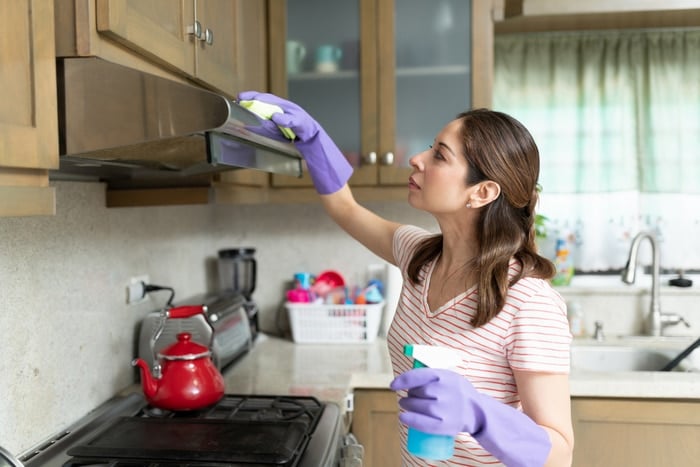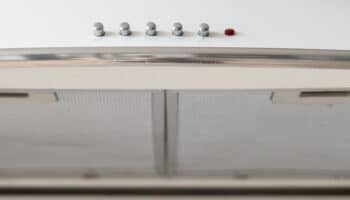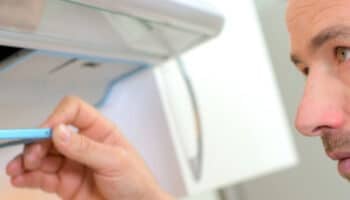Does your range hood smell bad?
You’re not alone! It can be quite annoying when you turn on your range hood to remove cooking vapors, only to find an unpleasant smell instead.
Don’t worry, though. I’m here to help.
If there’s a bad smell from your range hood, you’ll need to clean the filter, tray, duct, and surface. It’s also important to check the fan blades and inspect the wiring. Remember that regular maintenance prevents unpleasant odors and ensures the unit’s efficiency.
Keep reading to learn more about how to eliminate the unpleasant smell from your range hood!
Range Hood Smells Bad? Try These 6 Simple Fixes!
If you notice a bad smell from your range hood, the internal components likely need cleaning.
In this section, I’ll guide you through the six steps you should follow to clean and inspect your range hood to eliminate the unpleasant odor.
To solve the problem, you’ll need to access certain components, such as the grease filter. So, having the owner’s manual handy is crucial.
Are you ready? Let’s dive in!
#1 Clean the Grease Filter
I find that when a range hood smells bad, it’s typically due to a dirty filter.
The filter is responsible for trapping grease particles from the kitchen to prevent them from entering the range hood’s ventilation system. Over time, the filter can become clogged with grease and food debris.
If you haven’t cleaned your range hood’s filter in a while, the trapped grease and debris can lead to bacterial growth. Additionally, a clogged filter restricts airflow, causing your range hood to be less effective at removing cooking odors, allowing them to linger in the kitchen instead of being vented outside.

Follow these simple instructions to clean your range hood’s grease filter:
- Let your range hood cool down before removing the filter.
- Locate the filter, which is typically underneath the range hood.
- Carefully remove the filter by sliding it out or pressing the latch. The process of removing the filter will vary depending on your range hood’s model, so please refer to the owner’s manual for detailed instructions.
- Mix hot water with dish soap in a sink or basin. Then, let the filter soak for a few hours or overnight.
- Use an old toothbrush to gently scrub the filter. For stubborn grease spots, consider using a commercial kitchen degreaser.
- Rinse the filter thoroughly with warm water and let it dry to prevent a musty smell. You can use a soft cloth to speed up the drying process.
Note: If your grease filter has a “dishwasher-safe” symbol or label, you can clean it in the dishwasher.
Remember to clean your range hood’s filter every month. Keep in mind that if the filter is excessively greasy or made of charcoal, you’ll need to replace it with a new one.
#2 Clean the Grease Tray or Cup
If your range hood smells bad, it’s also important to clean the grease tray or cup.
The grease tray or cup collects any excess grease that doesn’t get trapped by the filter. It is commonly found in commercial, high-end, and ventless range hoods.
So, if your range hood comes equipped with a grease cup or tray and you haven’t cleaned it in a while, the accumulated grease can start to break down and provide an environment for bacterial growth, leading to unpleasant odors.
To clean your range hood’s grease tray or cup, you’ll need to:
- Make sure the range hood is turned off and cool to the touch.
- Locate the grease tray, which is typically beneath the filter. If needed, consult the manufacturer’s manual for detailed instructions on accessing the grease cup or tray.
- Remove the cup or tray and pour the collected grease into a proper waste container. You should never pour grease or oil down the drain.
- Fill the kitchen sink with warm, soapy water and let the tray soak for a couple of hours. If it has never been cleaned, allow it to soak overnight.
- Use a soft brush to scrub the grease tray or cup. For stubborn residue, use a commercial kitchen cleaner.
- Rinse the tray or cup under warm running water and let it dry.
- Once the grease tray or cup is dry, reinstall it.
To ensure your range hood’s efficiency and prevent unpleasant odors, my usual advice is to clean the grease tray or cup every month.
#3 Check the Duct
If you still notice a bad smell from your range hood, it’s time for us to inspect the duct.
The duct is responsible for venting smoke, grease, and cooking vapors out of your kitchen. Sometimes, grease can find its way into the duct and stick to the interior walls, which can restrict airflow and result in an unpleasant odor.
Additionally, when the moist air from cooking cools down inside the ductwork, it can condense and mix with the accumulated grease, leading to mold growth and a musty smell.
Follow these simple instructions to clean your range hood’s duct:
- Turn off your range hood at the circuit breaker and let it cool down.
- Remove the vent cover, filters, and all the necessary panels to access the duct using a screwdriver.
- Look inside the ductwork using a flashlight.
- Use a long, flexible brush to loosen any accumulated grease inside the duct. If necessary, use a putty knife and a commercial kitchen degreaser.
- Rinse the area with a cloth dampened with water. Then, dry the inside of the duct with a microfiber cloth.
- Reassemble your range hood.
Please note that if you don’t feel comfortable cleaning and inspecting your range hood’s duct, it’s best to call a professional. They have specialized tools to check the ductwork properly.
#4 Clean the Surface
When cleaning a range hood that smells bad, I always focus on the surface.
Over time, grease and dust can accumulate on your range hood’s surface, leading to bacterial growth and unpleasant odors. Therefore, it’s crucial to clean the surface regularly.

To clean your range hood’s surface, you’ll need to:
- Prepare the cleaning solution by mixing water with either dish soap or vinegar.
- Pour the cleaning solution into a spray bottle and generously spray it over the exterior surface of the range hood.
- Let the cleaning solution sit for a couple of minutes to break down any grime or grease.
- Wipe down the surface with a clean cloth or sponge. If you’re struggling with stubborn grease spots, consider using a commercial kitchen degreaser.
- Use a clean, damp cloth to wipe down the surface and remove any product residue.
- Finally, dry the surface with a microfiber cloth.
Note: If you have a stainless steel range hood, please use a compatible cleaner and follow the product’s instructions.
#5 Inspect the Fan Blades
If you still notice a bad smell from your range hood, you’ll need to inspect the fan blades.
The fan is responsible for drawing in steam, smoke, and grease from your kitchen while you’re cooking. Over time, these particles can stick to the blades, creating an environment where bacteria can thrive. When the blades rotate, they can release these unpleasant-smelling particles into the air.
Dirty fan blades can also affect your range hood’s efficiency and increase noise and vibration. So, cleaning them immediately is crucial.
To clean your range hood’s fan blades, you’ll need to:
- Turn off your range hood and remove the grease filter to access the fan.
- Use a kitchen degreaser and a soft cloth to wipe the fan blades. For stubborn debris, let the degreaser sit for a couple of minutes before wiping. You can also use an old toothbrush.
- Use a damp cloth to wipe off the cleaning product.
- Dry the fan blades with a microfiber cloth to prevent a musty smell.
- Turn your range hood back on.
While cleaning the fan blades, please look for any visible signs of damage. If necessary, get a replacement.
#6 Examine the Wiring
If your range hood smells like burning, I recommend inspecting the wiring.
You see, if the insulation on your range hood’s wires is damaged, it can overheat and give off a burnt plastic odor. Damaged wiring can also lead to multiple performance issues and, in extreme cases, fire hazards.
To inspect your range hood’s wiring, please turn off the power to the unit and remove the filters and any other components to access the wires. Refer to the owner’s manual for detailed instructions.
Then, look for any signs of damage, such as loose, frayed, or burnt wires. If you notice any loose connections, please reconnect them. However, if the wires look damaged, you’ll need to replace them.
Inspecting and repairing your range hood’s wiring can be a bit challenging. Therefore, if you’re not an experienced DIYer, it’s best to call a professional.
Wrapping Up: How to Keep Your Range Hood Odor-Free
Hopefully, now you know how to eliminate the bad smell from your range hood.
Remember, to keep your range hood from smelling bad, you’ll need to clean the grease filter, cup or tray, duct, and surface with soapy water or a kitchen degreaser. Don’t forget that it’s also important to inspect the fan blades and wiring.
Thank you so much for reading this quick guide. If you ever experience a different issue while using your range hood, please check out our related articles below.
Have a great day!










